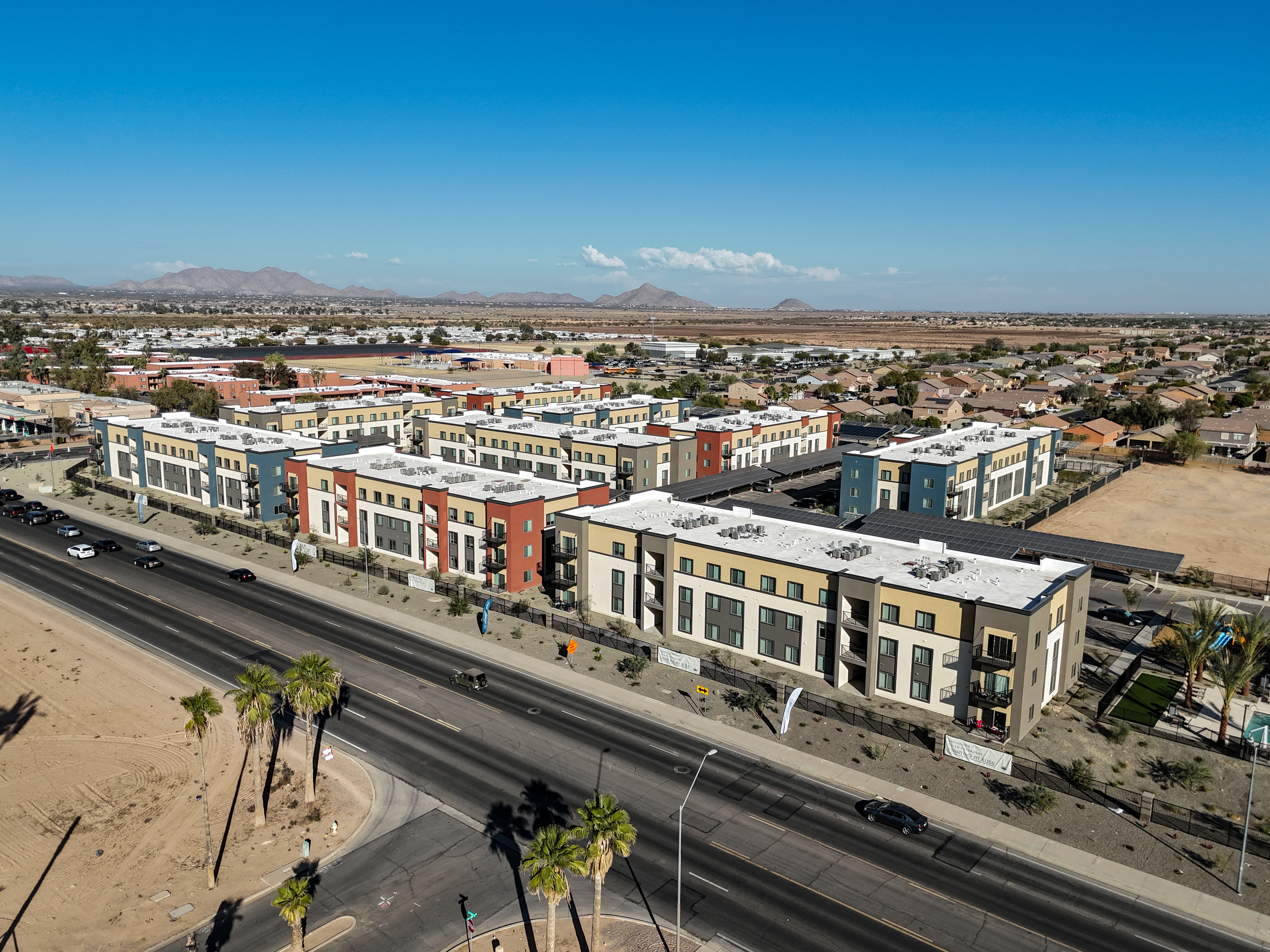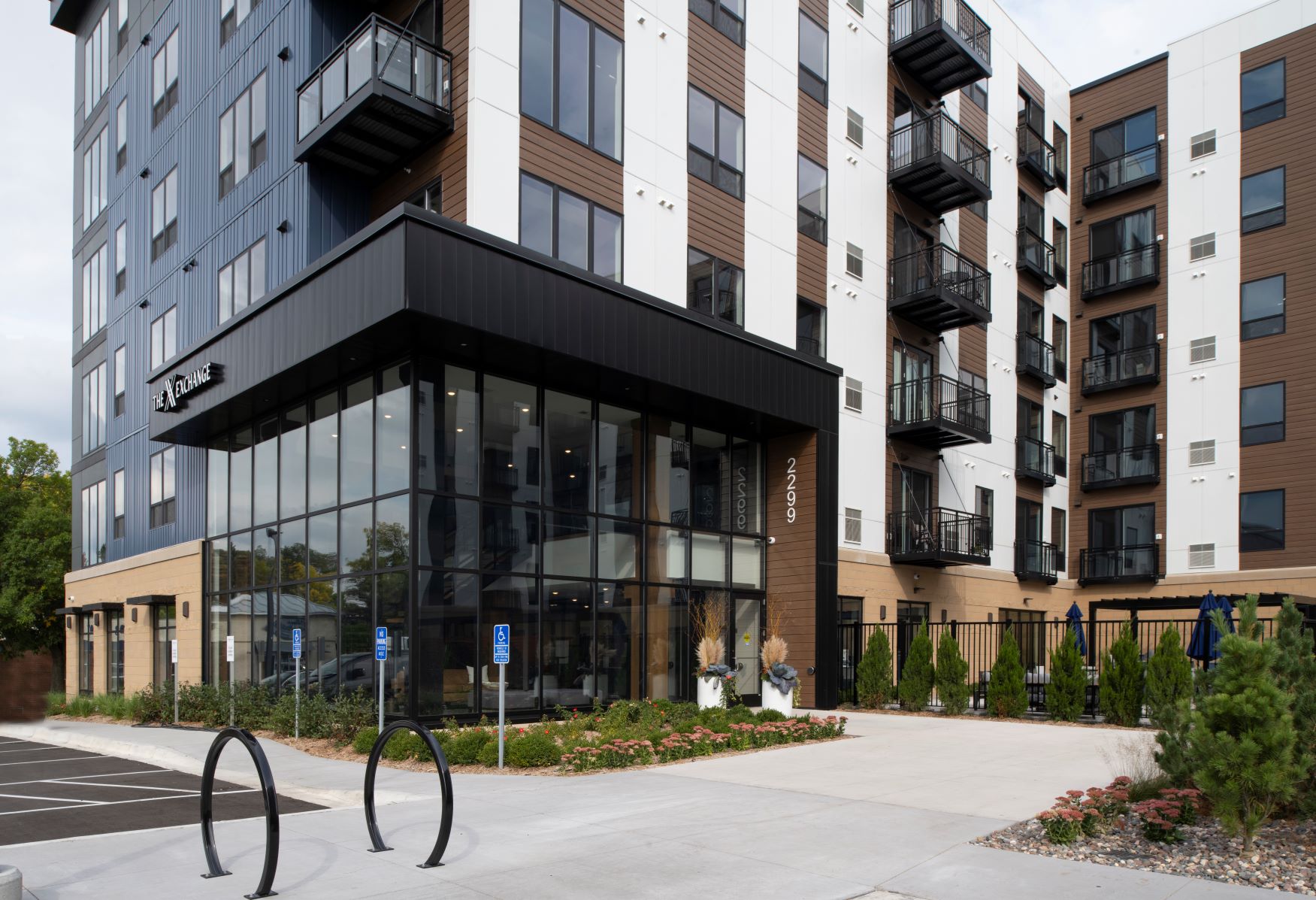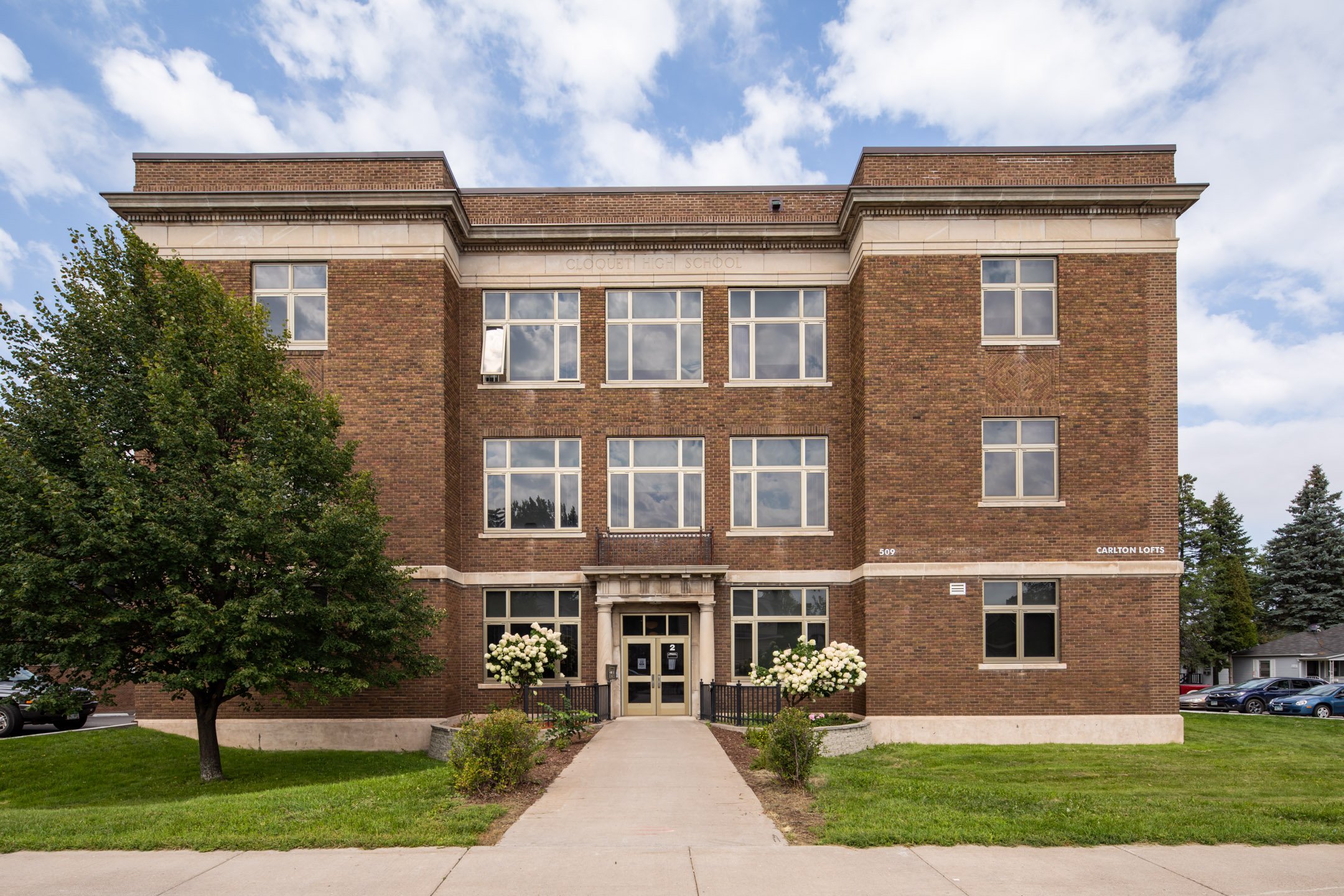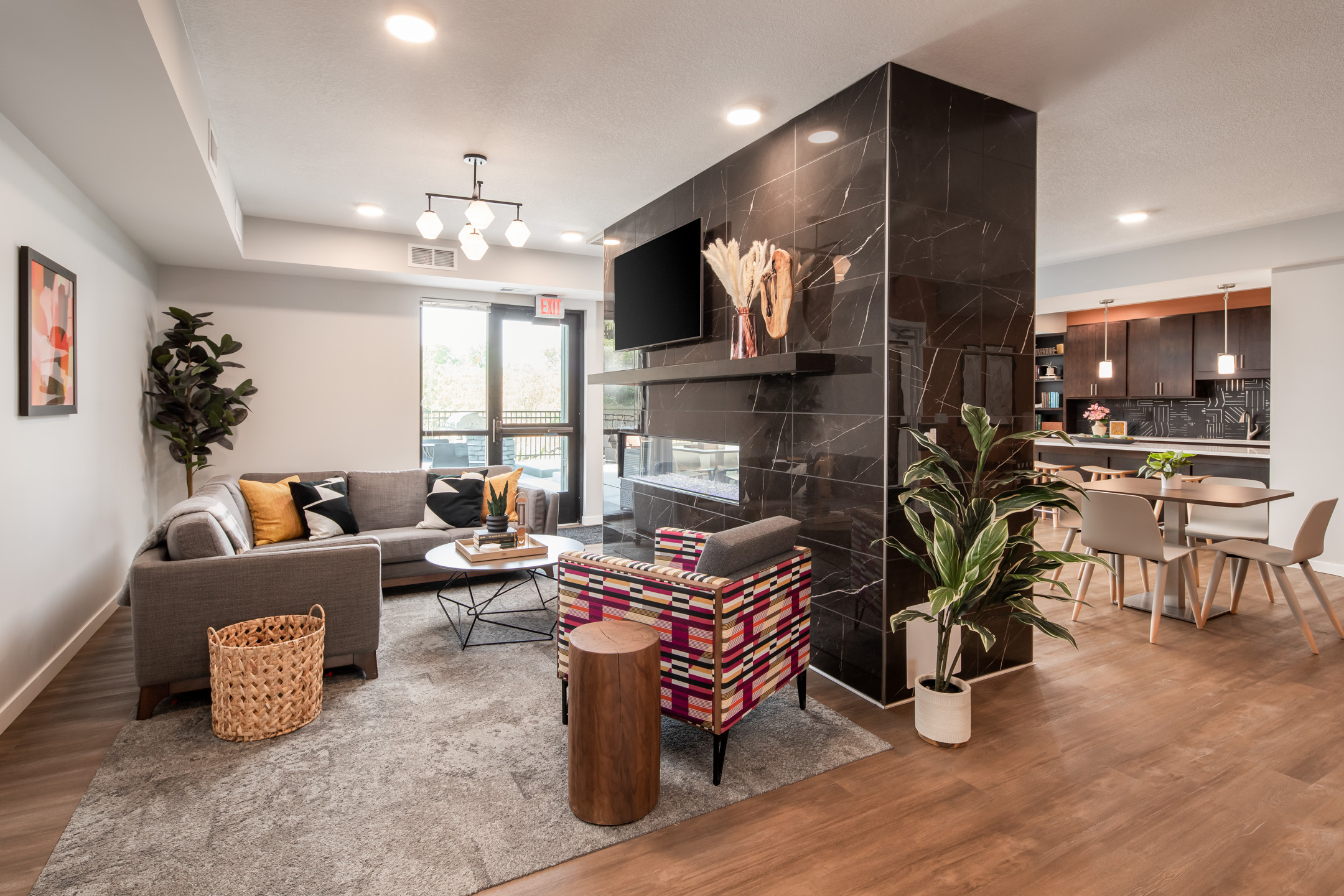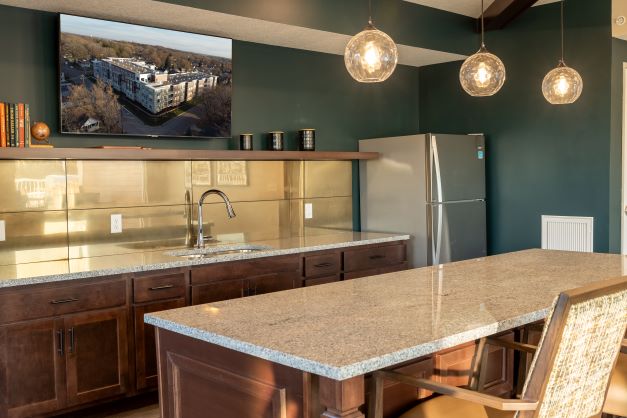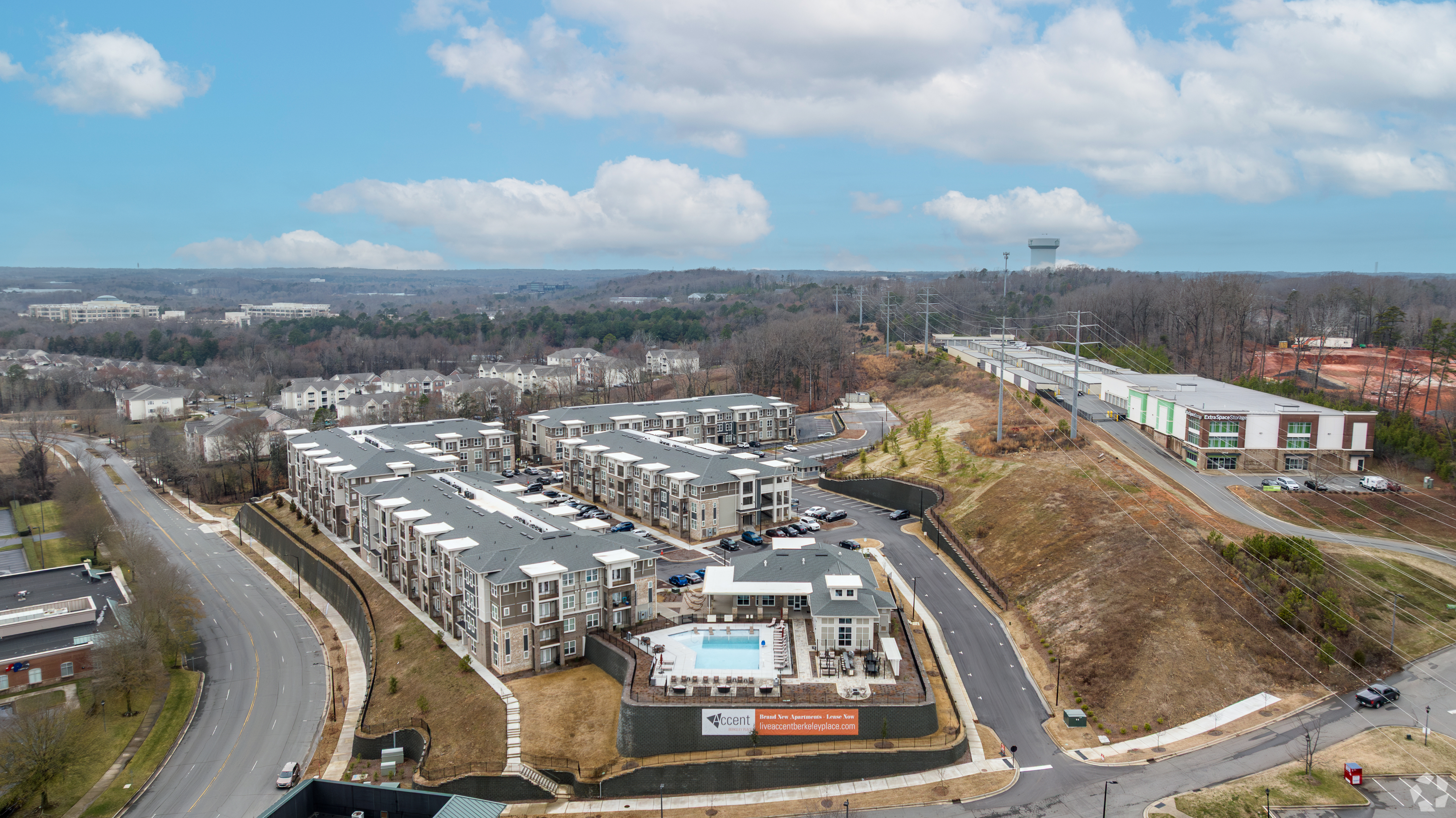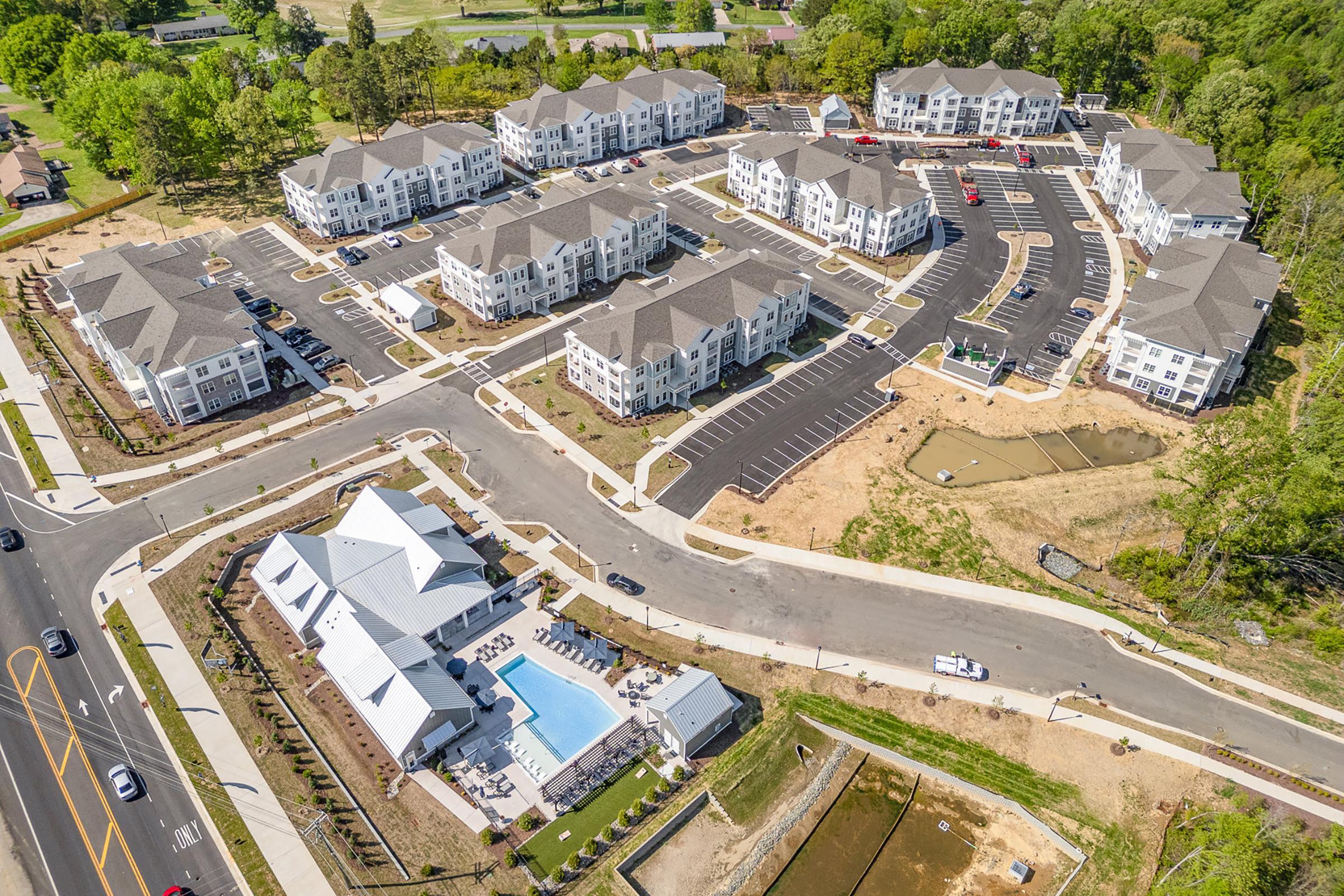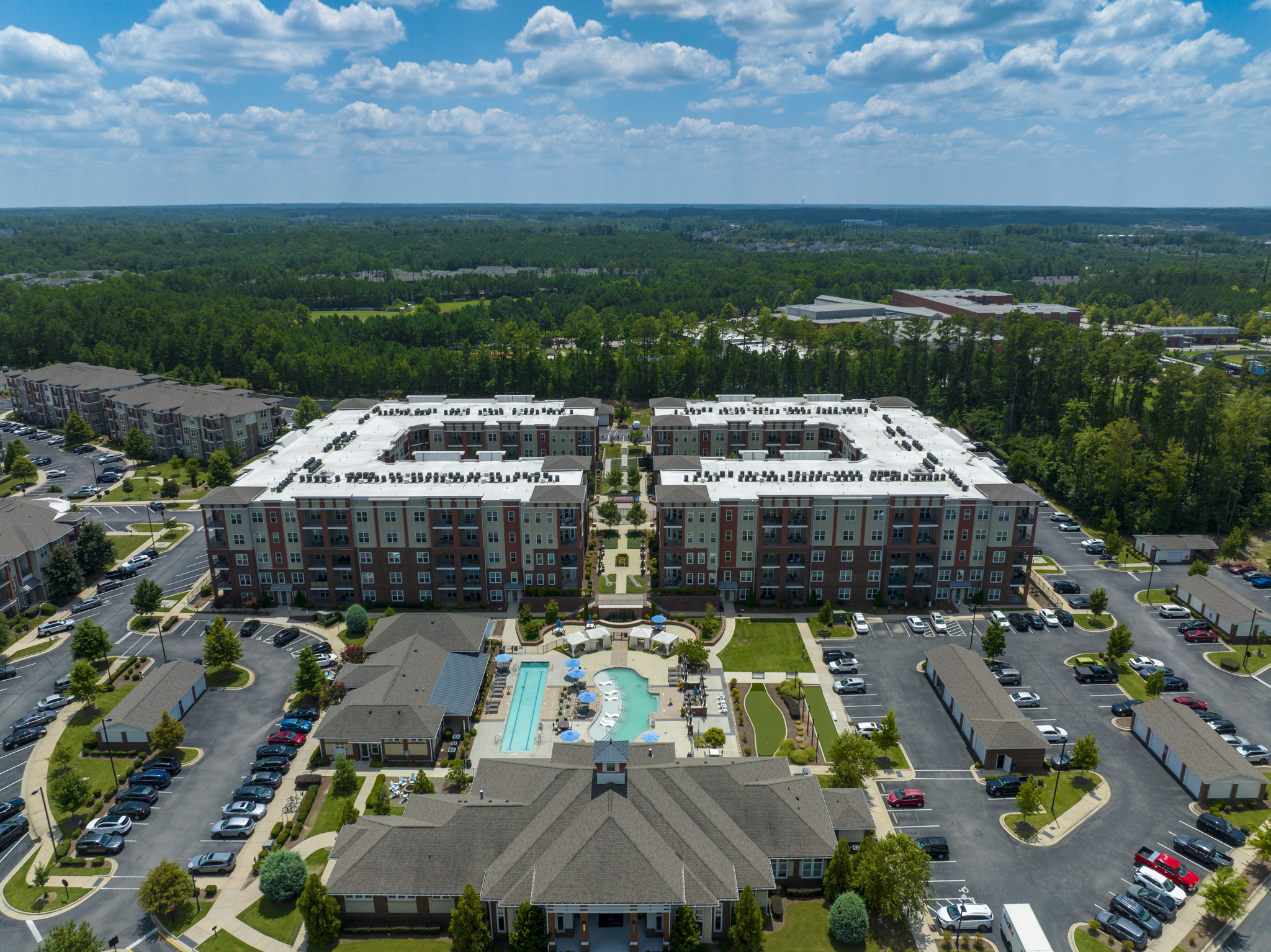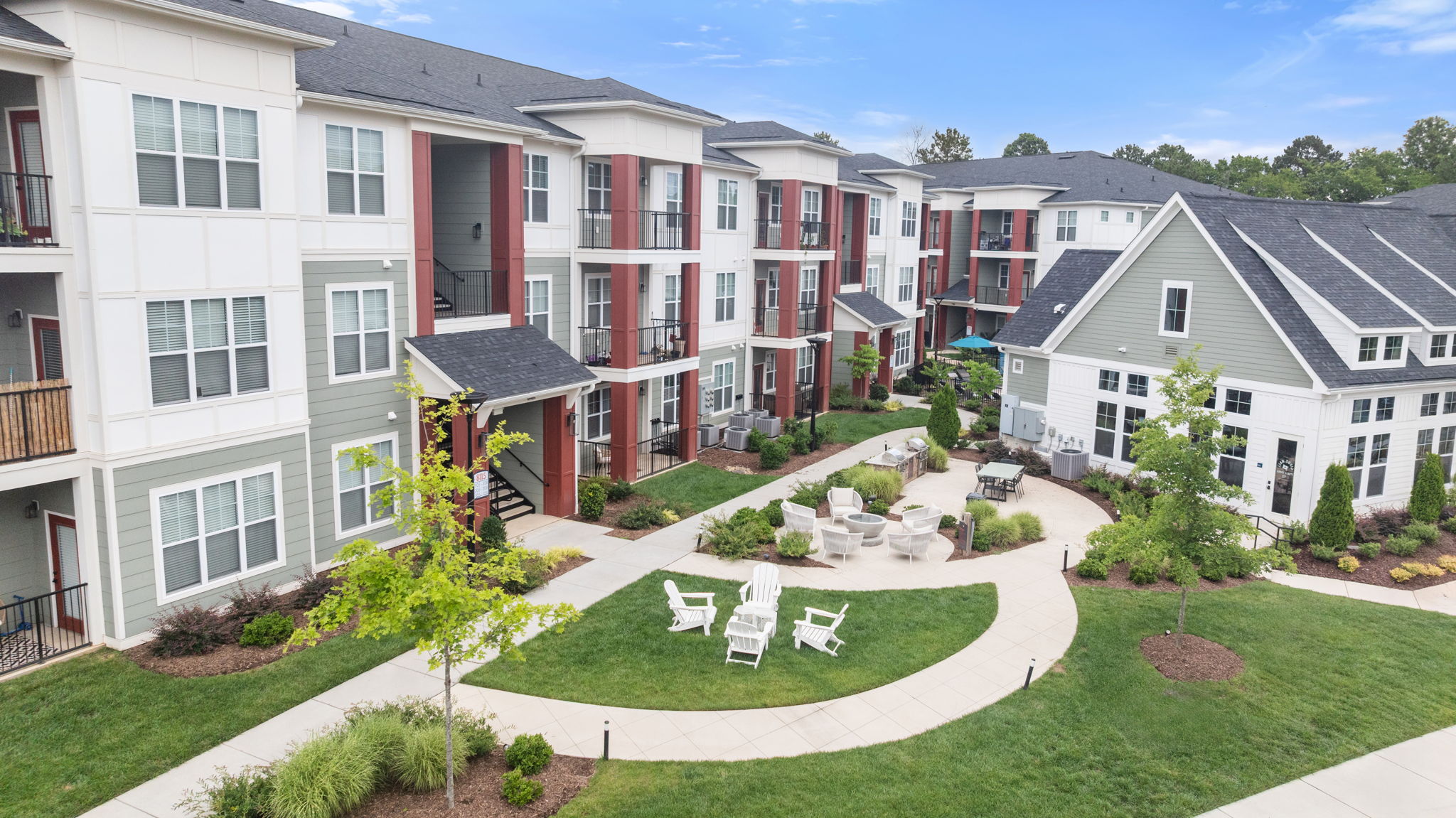Welcome to Verdant Apartments—the latest in affordable multi-family housing in St. Paul!
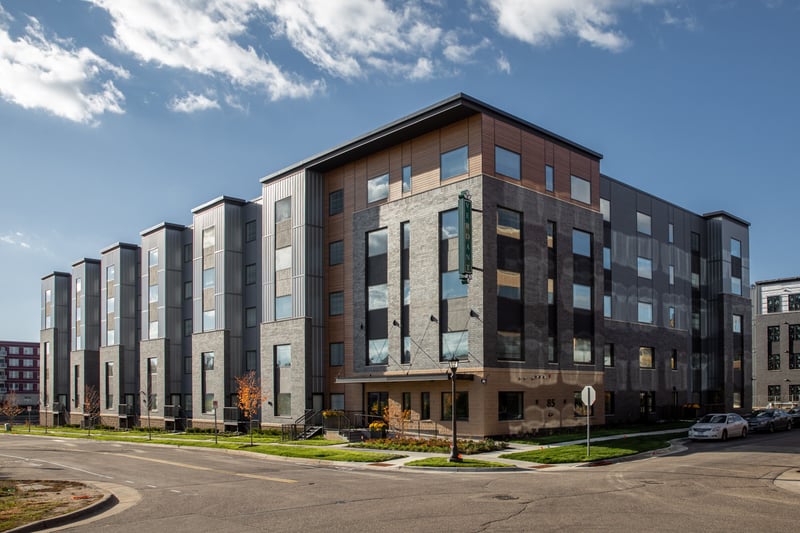
See additional photos from this project.
Here at Kaas Wilson, we couldn’t be more thrilled about the work our team did to bring this project to life. With modern multi-family architecture and beautiful, sustainable design, Verdant Apartments provides affordable housing residents can thrive in.
Verdant Apartments: Bringing Affordable, Modern Multi-Family Architecture to St. Paul
Verdant Apartments is a five-story, wood-framed, 82-unit affordable multi-family housing project in the West Side Flats neighborhood of St. Paul, near the Mississippi River.
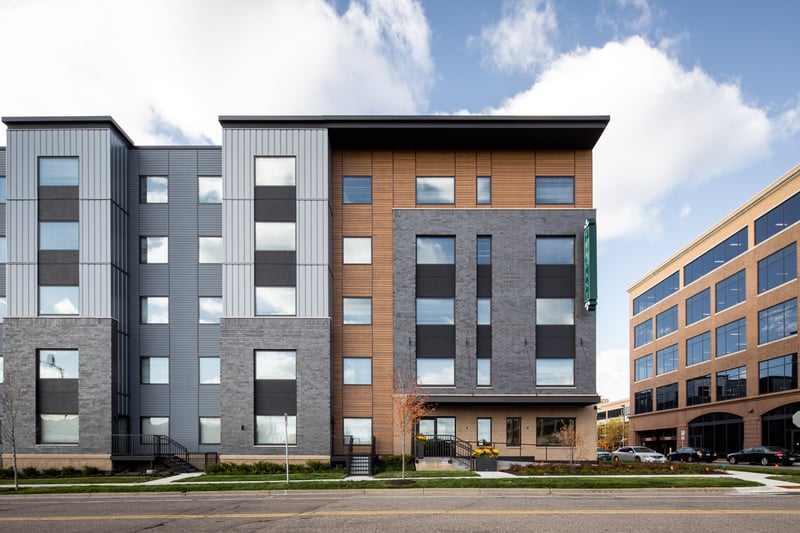
See additional photos from this project.
This project embodies modern multi-family architecture, including a concrete and masonry underground parking garage on the lowest level with 72 covered parking stalls. The parking garage’s footprint is larger than the residential building above, creating an outdoor plaza space that is used for a tot lot and two accessible surface parking stalls.
As a result of the developer’s partnership with the City of St. Paul, this project took on the ambitious goal of becoming only the second multi-family building in Minnesota to achieve the PHIUS(Passive House Institute US) certification.
3 Primary Challenges We Faced With This Design
1. Noncombustible Exterior Wall Design
Due to the city’s master plan for the design of the riverfront area, this building was required to be five stories tall. From a building code perspective, this meant a noncombustible exterior wall design was required.
Because the use of foam plastic insulation is strictly limited in noncombustible construction, it was a challenge to meet the high insulation and reduced thermal bridging required for PHIUS certification.
Our team had to get creative.
To solve this challenge, we designed a wall assembly that met the fire-resistive requirements of the building code while maintaining durability and airtightness and providing enough insulation value to meet the rigorous energy use targets of Phius.
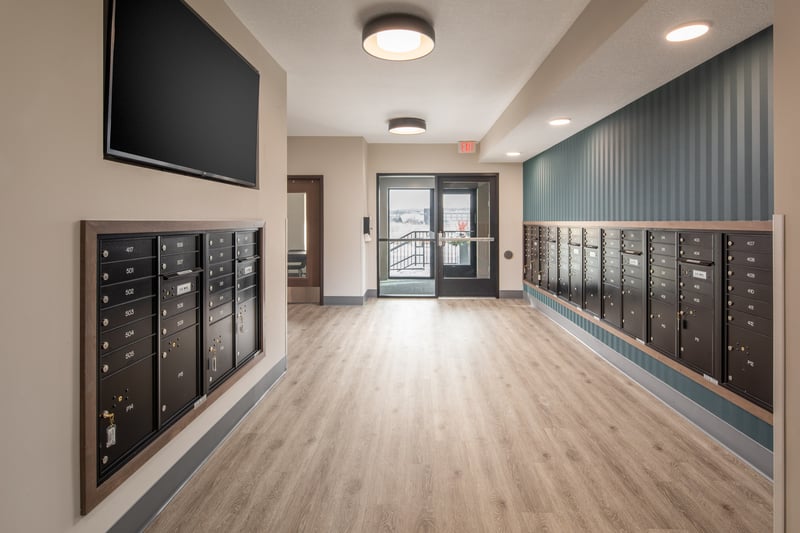
See additional photos from this project.
We framed the exterior portion out of fire-retardant-treated lumber and made the interior portion out of non-load-bearing metal studs. The gap between the two portions of the wall was filled with mineral wool insulation.
This increased the thermal performance of the wall by creating a thermal break between the structural wall and the interior of the building. Our team decided to install the primary air barrier system in the center of the wall, which entailed a continuous self-adhered membrane sheet air and vapor barrier.
Concerns regarding condensation and mold are extremely critical with highly insulated and airtight assemblies like this, since their drying potential is limited.
So in addition to meeting energy goals for this project, our team had to perform a thorough hygrothermal analysis to ensure the wall assembly would manage moisture with no risk of mold growth.
2. Reducing Thermal Bridging in Critical Junctions
The underground parking garage and associated plaza space also presented unique challenges for our project team.
The locations where the residential portions of the project connected to the parking garage were critical junctions that caused thermal bridging and increased the building's estimated energy use. Our design team detailed each of these intersections and analyzed them using THERM software, which quantifies the exact impact thermal bridging would have on annual energy use.
This information enabled our team to work with the structural engineer and the contractor team to limit thermal bridging by strategically creating gaps between structural elements and filling them with insulation to create thermal breaks. They then re-analyzed the updated details in THERM to confirm the reduced impact on projected energy use.
3. Designing and Installing a Dedicated Outdoor Air System (DOAS)
To meet the low energy-use targets for Phius certification, our team needed to design and install a DOAS that supplied and exhausted ventilation air for the entire building separately from the heating and cooling system.
The final design supplies and exhausts all ventilation air through a large Energy Recovery Ventilator (ERV) located on the roof.
To get the required amounts of supply and exhaust ventilation air to every corner of the building, the mechanical contractor had to install a vast array of ductwork running down the corridors of every level and then up the mechanical shafts to the ERV on the roof.
The general contractor and mechanical contractor worked together to provide a compact installation that allowed for the most finished headroom possible in the corridors.
The mechanical contractor was also able to meet rigorous duct air-leakage testing limits as well as the intense testing and balancing protocols of PHIUS. They worked with a testing and balancing contractor to test every single supply and exhaust grill in the project, ensuring airflow was within 10% of the CFM values shown on the mechanical plans.

See additional photos from this project.
Close Collaboration With Our Contractor Team Was Crucial
Construction of this project required strong collaboration with a team of contractors.
For instance, the unique non-combustible double exterior wall necessitated detailed coordination with the contractor team. There were many additional layers within the assembly, which were atypical, requiring custom sequencing. Performance of the exterior wall and the extreme air tightness levels demanded by PHIUS certification hinged on near-perfect execution of the exterior details.
To achieve these aims, the entire team held pre-construction meetings to discuss air barrier sequencing and continuity.
The final blower door testing revealed that the building was significantly more airtight than the strict Phius standard, achieving measured air leakage for the whole building of .18 ACH50 or .0362 CFM50/SqFt enclosure area.
This is a testament to the project team’s cooperation as well as the contractors’ diligence and attention to detail, and will improve indoor air quality and reduce energy consumption for this building.
The Outcome: Efficient Multi-Family Housing With Contemporary, Sustainable Design
High Performing and Energy Efficient
This project incorporated an extremely rigorous number of building-science-based, high-performance features, leading to very low estimated energy use. These features were integrated while simultaneously achieving a high-quality aesthetic on both the interior and exterior and providing high-demand affordable housing units.
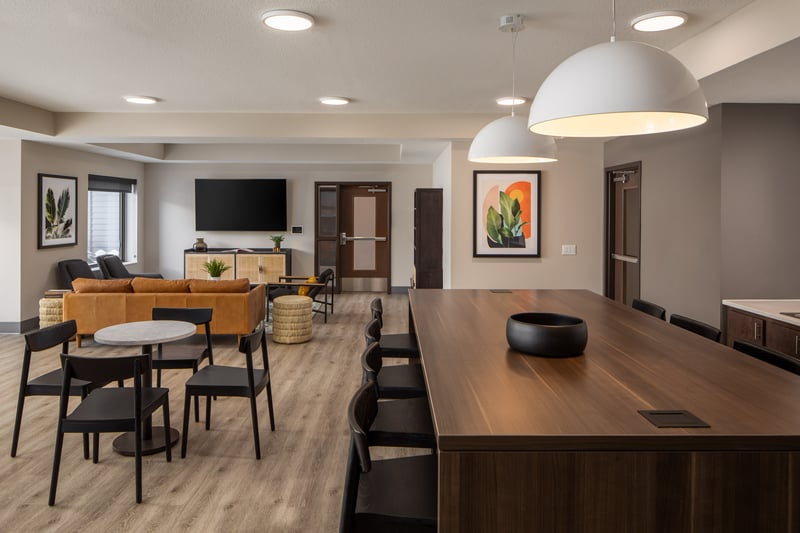
See additional photos from this project.
We selected top-quality durable materials to minimize future maintenance. All interior materials were specified to meet the requirements of the EPA indoor airPLUS program to ensure excellent indoor air quality for building residents.
Contemporary Design Utilizing High Quality Materials
The exterior façade is mostly made up of high quality metal panel siding and brick veneer, with “wood-look” cement fiberboard siding accenting the main entry.
For the interior design, we took inspiration from the project’s name, “Verdant,” meaning “the color of lush grass and vegetation.” Our color choices were inspired by nature’s color palette, including natural wood tones.
The result is a sleek, contemporary look, aided in part by a lack of mechanical penetrations and large windows free of mullions. We chose these features to increase building performance and make the project stand out from the majority of wood-framed multifamily projects.
Sustainable Design Certifications
As part of the Phius certification, this project was certified through the following programs:
- Energy Star Multifamily New Construction
- EPA Indoor airPLUS
- DOE Net-Zero Ready Homes
It was also built within these additional “green building” programs:
- City of St. Paul Green Building Policy
- Green Communities Criteria with Minnesota overlay
- Additional city requirements with portions of SB2030 and B3
In addition, this project has a number of features that contribute to overall sustainability, including:
- A high-performance envelope
- Triple-pane fiberglass windows
- A high-performance HVAC system
- High-efficacy and LED lighting fixtures
- Energy Star appliances
- A domestic hot water system with high-efficiency gas water heaters and a delivery system utilizing on-demand recirculation
As you can see, our team put a lot of hard work and creative problem solving into the design and build of this project. At Kaas Wilson, we enjoy a good challenge, and we couldn’t be more proud of the work our team did to make Verdant Apartments a reality.
Kaas Wilson architects is a unique architectural design firm using a collaborative approach to better understand and design specialized environments for work, home, and health. In conjunction with our clients and general contractors, we consistently produce award-winning projects. Contact us to learn how we can help bring your next project to life.
Search

Popular Posts

The Agave House Apartments in Casa Grande,...
An upscale, 132-unit market rate apartment...
Aster House is a brand new, 204-unit,...
ABOUT THE PROJECT
The Fern is a 55+...
Recent Posts

Growing Charlotte Team Nears 20 Employees...
Accent Berkeley Place Apartments in...
Westgate Landing Apartments in Charlotte,...
Discover The Aster in Cary, NC — a luxury...
Modern multifamily design in North...

